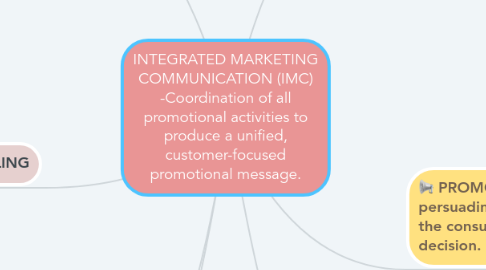INTEGRATED MARKETING COMMUNICATION (IMC) -Coordination of all promotional activities to produce a unified, customer-focused promotional message.
da Ruth Leong


1. PERSONAL SELLING
1.1. - Selling or introduced a product on a person to person basis with the buyers. For example international product such as Chanel, Miu Miu, Shiseido, Tom Ford, Christian Dior dan etc.
2. NON PERSONAL SELLING
2.1. 1. Advertising - Nonpersonal communication through media.
2.2. 2. Product placement - Marketer pays owner a fee to display their product in the film or show .
2.3. 3. Sales promotion - Marketing activities that stimulate consumer purchasing.
2.4. 4. Trade promotion - Sales promotion geared to marketing intermediaries.
2.5. 5. Direct marketing - Direct communication through customer.
2.6. 6. Public relations - Firm’s communications and relationships with public.
2.7. 7. Publicity - Nonpersonal stimulation of demand for a good, service, place, idea, person, or organization by unpaid placement.
2.8. 8. Guerrilla marketing - Unconventional, innovative, and low-cost techniques to attract consumers’ attention.
3. SPONSORSHIP
3.1. Organizations provide money or in-kind resources to an event or activity in exchange for a direct association with that event or activity.
4. PULLING AND PUSHING PROMOTIONAL STRATEGIES
4.1. PULLING STRATEGY- Promotional effort by the seller to stimulate final-user demand. Relies on advertising and sales promotion.
4.2. PUSHING STRATEGY - Promotional effort by the seller directed to members of the marketing channel rather than final users. Relies more heavily on personal selling.
5. COMMUNICATION PROCESS
5.1. 1. Sender - Convey message to receiver
5.2. 2. Message - information send by receiver
5.3. 3. AIDA - Step of an individual reaches a purchase decision.
5.4. 4. Encoding - Translate message into understandable terms.
5.5. 5. Decoding - Receiver’s interpretation of a message.
5.6. 6. Feedback - Receiver’s response to a message
5.7. 7. Noise - Stimulus that distracts a receiver from receiving message .
5.8. 8.Channel - Medium to send a message.
6. PROMOTION - Informing, persuading, and influencing the consumer’s purchase decision.
6.1. OBJECTIVE OF PROMOTION :
6.1.1. 1. Provide Information
6.1.2. 2. Increase demand in the market
6.1.3. 3. Accentuate the product’s value
6.1.4. 4. Differentiate the products.
6.2. PROMOTIONAL MIX - Subset of the marketing mix that marketers attempt to achieve the optimal blending of the elements of personal and nonpersonal selling to achieve promotional objectives.
7. DIRECT MARKETING
7.1. OBJECTIVE :
7.1.1. 1. increase store traffic
7.1.2. 2. Opens new international markets of unprecedented size.
7.1.3. 3. Promotes goals beyond creating product awareness.

